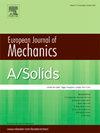电磁场和引力场作用下非对称转子的前后向内部共振
IF 4.2
2区 工程技术
Q1 MECHANICS
引用次数: 0
摘要
本文对电磁载荷和重力作用下的非对称转轴进行了全面的分析和数值研究。利用哈密顿原理和谐波平衡方法,建立了重力诱导的1:-1内共振(通过静挠度耦合前后旋转模式)以及超谐波和1:-1内共振的无量纲运动方程和调制方程。线性稳定性分析得到两个临界速度随电磁参数的增加而单调减小的坎贝尔图。主干曲线和频率响应分析表明,电磁软化效应使主干曲线向低速方向移动,峰值幅值减小,而重力作用引入了新的分岔、右倾响应分支和同时正向/向后不稳定的窄频率范围。在初级诱导的内部共振下,非对称系统显示出多达五个共存的稳态解(三个稳定),而对称系统中有三个(一个稳定)。相比之下,超谐波引起的内部共振产生多达七种解决方案,其中许多是不稳定的。分析预测结果与数值结果和时程/FFT模拟结果非常吻合。这些发现量化了电磁场、重力和不对称性对复杂模态相互作用开始的影响,为调整转子系统以避免高速应用中有害的内部共振提供了实用指南。本文章由计算机程序翻译,如有差异,请以英文原文为准。
Forward-backward internal resonances in asymmetrical rotors under electromagnetic and gravitational fields
This study presents a comprehensive analytical and numerical investigation of an asymmetrical rotating shaft subjected to electromagnetic loading and gravitational effects. Employing Hamilton principle and the harmonic balance method, dimensionless equations of motion and modulation equations for the gravity-induced 1:-1 internal resonance (via static deflection coupling forward and backward whirling modes), as well as simultaneous super-harmonic and 1:-1 internal resonances. Linear stability analysis yields a Campbell diagram with two critical speeds that decrease monotonically as the electromagnetic parameter increases. Backbone-curve and frequency-response analyses indicate that the electromagnetic softening effect shifts the backbone curves toward lower speeds and reduces peak amplitudes, while gravity introduces new bifurcations, right-inclined response branches, and narrow frequency ranges of simultaneous forward/backward instability. Under primary-induced internal resonance, the asymmetrical system exhibits up to five coexisting steady-state solutions (three stable), compared to three in the symmetrical system (one stable). In contrast, super-harmonic–induced internal resonance generates up to seven solutions, many of which are unstable. Analytical predictions show excellent agreement with numerical results and time-history/FFT simulations. These findings quantify the influence of electromagnetic fields, gravity, and asymmetry on the onset of complex modal interactions, offering practical guidelines for tuning rotor systems to avoid deleterious internal resonances in high-speed applications.
求助全文
通过发布文献求助,成功后即可免费获取论文全文。
去求助
来源期刊
CiteScore
7.00
自引率
7.30%
发文量
275
审稿时长
48 days
期刊介绍:
The European Journal of Mechanics endash; A/Solids continues to publish articles in English in all areas of Solid Mechanics from the physical and mathematical basis to materials engineering, technological applications and methods of modern computational mechanics, both pure and applied research.

 求助内容:
求助内容: 应助结果提醒方式:
应助结果提醒方式:


